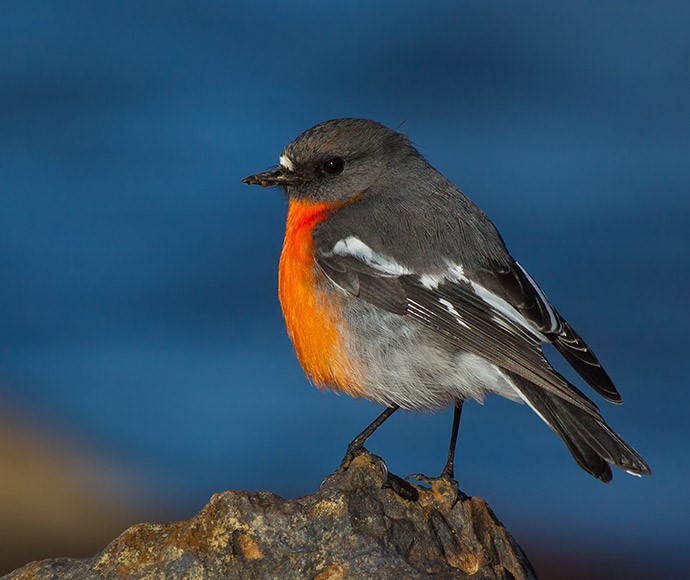Flame robin (Petroica phoenicea) - vulnerable species listing
The Scientific Committee, established by the Threatened Species Conservation Act, has made a Final Determination to list the Flame Robin Petroica phoenicea Gould 1837 as a VULNERABLE SPECIES in Part 1 of Schedule 2 of the Act. Listing of Vulnerable species is provided for by Part 2 of the Act.
NSW Scientific Committee - final determination
The Scientific Committee has found that:
1. The Flame Robin Petroica phoenicea Gould 1837 is a small (14 cm) songbird with dark grey upperparts, orange-red underparts from chin to belly, a small white forehead spot, and white flashes in the wings and tail. The female is brown with white flashes in the wings and tail. The Scarlet Robin Petroica boodang is similar, but the male has black upperparts and throat, a red breast, white lower belly, and a large white forehead spot, while the female has a red-tinged breast.
2. The Flame Robin is found in south-eastern Australia (Queensland border to Tasmania, western Victoria and south-east South Australia). In NSW it breeds in upland moist eucalypt forests and woodlands, often on ridges and slopes, in areas of open understorey. It migrates in winter to more open lowland habitats such as grassland with scattered trees and open woodland on the inland slopes and plains (Higgins and Peter 2002). There may be two disjunct breeding populations in NSW on the Northern Tablelands and the Central–Southern Tablelands (inferred from distributional data in Barrett et al. 2003 and the NSW Wildlife Atlas).
3. The Flame Robin forages from low perches, feeding on invertebrates taken from the ground, tree trunks, logs and other coarse woody debris. The robin builds an open cup nest of plant fibres and cobweb, which is often near the ground in a sheltered niche, ledge or shallow cavity in a tree, stump or bank. Generation length has been estimated as 5 years (Garnett and Crowley 2000).
4. In recent decades the Flame Robin is believed to have undergone a moderate reduction in population size in NSW based on comparative evidence from broadscale surveys. It was reported in 42 one-degree grids in NSW during the first national bird atlas in 1977-81 at mostly moderate to high reporting rates (Blakers et al. 1984). During the second national bird atlas in 1998-2002 it was recorded in 39 one-degree grids at mostly low reporting rates (Barrett et al. 2003). The index of abundance (reporting rate) over the 20 years between the two atlases declined significantly by 56% in NSW and 57% nationally, with no variation between bioregions (Barrett et al. 2003, 2007). Assuming a linear decline this is equivalent to a state and national decline of 46% over three generations (15 years) the time frame recommended by IUCN (2008) for estimating population change. The robin was not less likely to be detected in Atlas 2 versus Atlas 1 due to the different survey methods (Barrett et al. 2003) and therefore comparison of the two atlases is unlikely to be significantly affected by survey bias.
5. The Flame Robin's index of abundance (reporting rate) is positively associated with native vegetation cover (Barrett et al. 2007). Clearing and degradation of breeding habitat, and degradation of wintering habitat are key threats to the species. For instance, habitat in the sheep-wheat belt is subject to degradation by overgrazing and simplification by the removal of standing dead timber, logs and coarse woody debris. Core breeding bioregions (New England Tableland and South Eastern Highlands) are 53-58% cleared and moderately to highly stressed (landscape stress factor 3-6 out of 6), and a core wintering bioregion (NSW South Western Slopes) is 84% cleared with a stress rating of 5 (Morgan 2000; Barrett et al. 2007). 'Clearing of native vegetation' and 'Removal of dead wood and dead trees' are listed as Key Threatening Processes in NSW under the Threatened Species Conservation Act 1995. The species suffers a high rate of nest predation by native and exotic predators, including artificially large populations of Pied Currawong Strepera graculina in some areas (Higgins and Peter 2002).
6. The Flame Robin Petroica phoenicea Gould 1837 is not eligible to be listed as an Endangered or Critically Endangered species.
7. The Flame Robin Petroica phoenicea Gould 1837 is eligible to be listed as a Vulnerable species as, in the opinion of the Scientific Committee, it is facing a high risk of extinction in New South Wales in the medium-term future as determined in accordance with the following criteria as prescribed by the Threatened Species Conservation Regulation 2002:
Clause 14
The species has undergone, is observed, estimated, inferred or reasonably suspected to have undergone or is likely to undergo within a time frame appropriate to the life cycle and habitat characteristics of the taxon:
(c) a moderate reduction in population size,
based on:
(d) an index of abundance appropriate to the taxon.
Dr Richard Major
Chairperson
Scientific Committee
Proposed Gazettal date: 12/02/10
Exhibition period: 12/02/10 – 09/04/10
References:
Barrett G, Silcocks A, Barry S, Cunningham R, Poulter R (2003) 'The new atlas of Australian birds.' (RAOU: Melbourne)
Barrett GW, Silcocks AF, Cunningham R, Oliver DL, Weston MA, Baker J (2007) Comparison of atlas data to determine the conservation status of bird species in New South Wales, with an emphasis on woodland-dependent species. Australian Zoologist 34, 37-77.
Blakers M, Davies SJJF, Reilly PN (1984) ‘The atlas of Australian birds.’ (Melbourne University Press: Melbourne)
Garnett S, Crowley G (2000) 'The action plan for Australian birds 2000.' Environment Australia: Canberra)
Higgins PJ, Peter JM (2002) 'Handbook of Australian, New Zealand and Antarctic birds (vol. 6).' (Oxford University Press: Melbourne)
IUCN (2008) 'Guidelines for using the IUCN Red List Categories and Criteria. Version 7.0.' (Standards and Petitions Working Group of the IUCN Species Survival Commission Biodiversity Assessments Sub-committee: Switzerland).
Morgan G (2000) 'Landscape health in Australia: A rapid assessment of the relative condition of Australia's bioregions and subregions.' (Environment Australia: Canberra)
